The Imaging Resource
Quick Review
Samsung Digimax i5 Digital Camera
| Samsung Digimax QuickLook | ||
| Review Date |
|
|
| User Level |
|
|
| Product Uses |
|
|
| digital camera Design |
|
|
| Picture Quality |
Very Good, 5.0-megapixel CCD | |
| Print Sizes |
11x17s or 8x10s with heavy cropping | |
| Availability |
Now | |
| Suggested Retail Price (At introduction) |
|
|
|
||||||||||
Samsung's Digimax i5 digital camera is easily one of the sleeker camera designs out on the market. You're sure to get some inquisitive looks when you slip it out of your shirt pocket. With a design aesthetic that leaves the i5's purpose a little up in the air, the camera's techno-gadget look will keep people guessing, until you uncover the lens and actually point it like a camera. Our evaluation unit arrived with a "Shark Silver" finish, but you can also purchase the Samsung Digimax i5 in red, black, or a darker, charcoal tone. A small window on the camera's front panel houses the lens and flash, with an automatic cover that keeps the front panel smooth and featureless when closed (though the lens doesn't even protrude when shooting). Compact and light weight, the Samsung i5 measures only 3.43 x 2.36 x 0.67 inches (87 x 60 x 17 millimeters), and weighs only 5.4 ounces (154 grams) with the battery and memory card loaded. The i5 is definitely pocket-friendly, with no protrusions to hang on pockets. The 5.0-megapixel CCD captures high resolution, print quality images (up to 11x17 inches with good detail, or 8x10 with heavy cropping), as well as smaller image sizes better suited for distributing via email.
The Samsung Digimax i5 offers a fairly standard 3x zoom lens, equivalent to a 39-117mm zoom on a 35mm camera. (That's a modest wide angle to a moderate telephoto.) The camera's AF area is highlighted in the LCD display with a white rectangular outline, but you can use one of four AF preset frames available through the Special Effects menu option. (The focus frames outline a person(s) in the frame, to help you line up portrait shots. There's also a larger AF area outline frame.) The Samsung i5 has a maximum aperture ranging from f/3.5 to f/4.5, depending on the zoom position. Focus ranges from 19.69 inches (50 centimeters) to infinity in normal mode, with a Macro mode getting as close as 1.97 inches (5 centimeters). A Super Macro mode gets even closer, 1 to 5 centimeters. In addition to the 3x optical zoom, the i5 also offers as much as 5x digital zoom, which effectively increases the camera's zoom range to a total of 15x. Keep in mind though, that digital zoom decreases the overall image quality, since it just stretches the center pixels of the CCD image. For composing images, the Samsung Digimax i5 offers a generous 2.5-inch color LCD monitor.
The Samsung Digimax i5 offers automatic and "manual" exposure control, as well as a range of 11 preset Scene exposure modes. What Samsung dubs "manual" mode, is really just Program AE exposure control. Auto mode keeps the camera in charge of everything, while the Manual mode gives back control over everything except shutter speed and aperture. Though you can't adjust the aperture and shutter speed directly in most modes, the camera does report its chosen settings on the LCD monitor's information display, whenever the Shutter button is halfway pressed. The Mode button on rear panel offers options of Movie and Still record modes, though you can expand the offerings through the record menu to include all of the available exposure modes and the 11 scene modes. Scene offerings include Night, Portrait, Children, Landscape, Close up, Text, Sunset, Dawn, Backlight, Fireworks, and Beach & Snow. Worthy of note here is the Night preset mode, which actually does allow you to change the aperture and shutter speed, unusual (and welcome) in a "scene" mode. Pressing the +/- button on the back panel offers both selections, with shutter times as long as 16 seconds available.
The Samsung Digimax i5 employs a Multi metering system, which bases the exposure on several light readings taken throughout the frame, though you can switch over to Spot mode through the record menu. You can increase or decrease the overall exposure from -2 to +2 exposure equivalents (EV) in one-half-step increments. White balance options include Auto, Daylight, Cloudy, Fluorescent H, Fluorescent L, Tungsten, and Custom settings. An ISO option offers equivalent settings of 100, 200, and 400, as well as an Auto setting. The Samsung i5 also offers Black and White and Sepia color modes, a Negative color effect, and Red, Blue, and Green color shift options. You can also adjust the in-camera sharpening. The built-in flash is effective from 0.66 to 7.87 feet (0.2 to 2.4 meters) depending on the setting of the zoom lens, and features Auto, Auto Red-Eye Reduction, Fill-in, Slow-Sync, and Off operating modes. The SF button on top of the camera enables its Safety Flash mode, which brightens the exposure in lower lighting without using the flash. After the image is captured, the camera digitally enhances the image to compensate for low lighting, though the flash is still preferable for very dim situations. A two- or 10-second Self-Timer mode provides a delay between the time the Shutter button is pressed and when the shutter actually opens, so you can get into your own shots. A Double Self-Timer features fires the shutter after 10 seconds, and again after two seconds. (A good way to insure against blown shots caused by someone blinking when the shutter fired.) Hidden away in the camera's LCD menu, under the Special Effects tab, is a Composite mode, which lets you create a composite image from as many as four pieces of separate images. The process is slightly time-consuming, but could be fun to play around with. (Still, it seems like one of those "Why did they bother?" features, at least in our opinion.)
In addition to its still photography modes, the Samsung Digimax i5 also offers a Movie recording mode for capturing moving images with sound. Maximum movie lengths depend on the amount of memory space available. Movies can be recorded at 640 x 480, 320 x 240, or 160 x 128 pixels, at either 30 or 15 frames-per-second. Within Movie mode (only), you can activate the camera's Image Stabilization technology, which helps reduce blurring from slight camera movement. Movie mode will be problematic for Mac users though - The i5's movies are saved in the AVI format, using MPEG-4 encoding. This format is reasonably compatible with Windows PCs, but Mac users will have to either download a pair of codecs to enable QuickTime to play them (poorly, I don't recommend it), or download another application. Using the DivX and XviD codecs, my Mac would play the movies, but with garbled sound. I had better luck using the VLC media player, a standalone application that runs on an amazing number of different operating systems. (VLC is still in beta as of this writing in early November, 2005, but it seems to work quite well.) MPEG-4 encoding does have the very significant advantage of compressing movies much more efficiently than older methods. This means you can cram a lot more movie footage into a given amount of memory.
A Continuous photography mode lets you capture a rapid succession of frames while you hold down the Shutter button, but "rapid" is a very relative term here, as the maximum frame rate is just under one frame per second. The upside though, is that the maximum number of images that can be captured seems to be limited only by memory capacity, as we managed 20+ images without pausing. The Samsung Digimax i5's audio recording options include a full Audio mode, accessed by pressing the up arrow of the Four-way navigational rocker, which records up to an hour of audio. (The down arrow starts and pauses recording.) You can also record short sound clips to accompany captured images while in Playback mode. Other interesting tricks the i5 has up its sleeve include the MyCam menu, for customizing the camera's startup images and sounds, a selection of photo borders or "frames" to dress-up images, and an album creation option for managing images in-camera.
The Digimax i5 is compatible with Samsung's accessory camera cradle (some units are bundled with the cradle), which provides quick image downloading and battery charging. Built into the i5 is 50 megabytes of internal memory (a pretty impressive capacity), but the camera also features an SD/MMC memory card slot so you can expand the camera's memory capacity. I highly recommend picking up at least a 128-megabyte card right away, given the camera's 2,592 x 1,944-pixel maximum resolution size, though cards are available as large as 2 gigabytes as of this writing in November, 2005. For power, the Samsung Digimax i5 uses a rechargeable lithium-ion battery pack, which accompanies the camera. Battery life seemed about average for a subcompact digital camera, which means "on the short side" when compared to full-size models. (Plan on buying a second battery to have on hand as a spare, if you intend any extended photo excursions with the i5.) Also packaged with the Samsung i5 are USB and AV cables, as well as a software CD loaded with the Digimax Viewer and Reader applications, and ArcSoft PhotoImpression software for downloading and managing images.
Basic Features
- 5.0-megapixel CCD delivering images as large as 2,592 x 1,944 pixels.
- 2.5-inch color LCD monitor.
- 3x, 39-117mm (35mm equivalent) lens.
- 5x digital zoom.
- Auto, Manual (Program AE), SF (Safety Flash), and Scene recording modes, with 11 preset "scenes."
- White Balance with seven settings, including a custom option.
- Maximum aperture of f/3.5 to f/4.5, depending on lens zoom position.
- Shutter speeds from 1/2,000 to 16 seconds, depending on exposure mode.
- Built-in flash with five modes.
- 50MB internal memory.
- SD/MMC card storage (optional, card not included).
- Power supplied by one rechargeable lithium-ion battery pack or optional AC adapter.
- Included camera dock for connection to a computer.
- Digimax Viewer, Digimax Reader, and ArcSoft PhotoImpression software included, plus Mac and Windows drivers.
Special Features
- Movie and Audio recording modes, with Image Stabilization for video files.
- Continuous and Composite photography mode.
- Color effects settings, plus a range of special effects.
- Adjustable ISO from 100 to 400, with an Auto setting.
- Two- or 10-second Self-Timer for delayed shutter release, plus a Double setting.
- Image sharpness adjustment.
- Macro (close-up) and Super Macro lens settings.
- DPOF (Digital Print Order Format) and PictBridge compatibility.
- USB cable for connection to a computer (driver software included).
Recommendation
Thin, compact, and sleek-looking, the Samsung Digimax i5 is a subcompact digital camera with surprising flexibility. Though it is primarily a point-and-shoot design, the i5 does offer some manual exposure control in its Night preset mode, in addition to a nice selection of Scene modes and creative options. The 5.0-megapixel CCD captures high-resolution images, and the i5's very large 2.5-inch color LCD monitor is a welcome inclusion. Most noteworthy though, is the camera's small size and low profile, making it a very pocket-friendly travel companion.
Sleek and compact, with limited controls and practically no protrusions, the Samsung Digimax i5 is easily one of the most chic digital cameras currently available. With stunning looks and a very pocket friendly design, the i5 goes just about anywhere you want it to, and you'll likely be swamped with curious compliments as soon as you whip it out of a pocket. The Samsung i5 measures only 3.43 x 2.36 x 0.67 inches (90 x 60 x 17 millimeters), and weighs just 5.4 ounces (154 grams) with the battery and memory card loaded. A wrist strap comes with the camera for added security when shooting, as does a soft camera case to help protect the attractive silver finish.
The Samsung Digimax i5's front panel appears almost featureless, except for a small window in the top right corner. An automatic lens cover inside the window slides out of the way when the camera is powered on, revealing the flash, lens and self-timer / AF assist lamp. There's no finger grip to speak of, so you'll want to keep that wrist strap securely in place whenever the camera is in-hand.
On the right side of the camera (as viewed from the rear) is simply the eyelet for attaching the wrist strap.
The opposite side of the camera is smooth and featureless.
On the camera's top panel are the Shutter, Power, and the SF buttons, as well as a tiny microphone and speaker.
The Samsung Digimax i5's few control buttons share the rear panel with the large 2.5-inch color LCD monitor, and a small series of raised bumps that serve as a thumbrest. A two-way Zoom rocker button crowns the top right corner, with the Mode, Playback, and Exposure Compensation/Delete buttons lining the side of the LCD panel. A Four-way navigational button with a central "OK" button is in the lower right corner, and serves a variety of functions.
The i5's bottom panel holds the camera dock connection jack, as well as the shared memory/battery compartment. The dock connection jack connects the camera directly to the included camera dock for quick image downloading. A sliding, hinged door covers the memory/battery compartment. Inside, the battery and memory card slots line up side-by-side, maximizing space. The Samsung Digimax i5 does not feature a tripod mount, though I doubt its users will mind, given the camera's highly portable nature.
The Samsung Digimax i5 is for the most part a user-friendly digital camera, although some of its features aren't obvious without perusing the manual, and it's user interface is different enough from most other cameras on the market that it can take a little getting used to. For basic shooting, you simply turn on the camera, select a recording mode, and fire the shutter. The Four-way navigational rocker button accesses a few camera settings, and the +/- button provides quick access to exposure compensation, ISO, white balance, and RGB values. The LCD menu system is fairly short and simple to navigate when you do need it. I found it a little non-intuitive to access the camera's preset Scene modes, but once I got the gist of things, it was easy enough to remember. Given the camera's limited controls and fairly simple interface, you should be shooting right out of the box. For more detailed features and exposure options though, you'll need to spend a little time combing through the manual.
Record-Mode Display
In Record mode, the i5's LCD displays a wide range of information, including exposure mode, battery level, flash setting, shooting mode, memory card status, zoom position, focus area, image capacity, image size and quality, ISO, and the date and time. You can also opt for a basic information display, accessed through the Record menu, which shows only the image capacity. Half-pressing the Shutter button displays the chosen aperture and shutter speed settings.
Playback-Mode Display
In Playback mode, the i5's LCD reports only the image number, in addition to the battery level. You can use the Zoom rocker to zoom in or out on an image, or to call up a thumbnail display of all saved images.
External Controls
Shutter Button: Located on the far right of the i5's top panel, this button sets focus and exposure when halfway pressed, and fires the shutter when fully pressed. In Playback mode, pressing this button returns the camera to the selected Record mode.
Power Button: To the left of the Shutter button, this button turns on the camera, placing it into record mode. This button also turns the camera off, signaling the lens cover to return.
SF Button: The final button on the top panel, this button enables the Safety Flash mode. (Safety Flash apparently post-processes images after the exposure, to emulate the effect of flash. The flash is not fired, however.)
Zoom Rocker Button: In the top right corner of the rear panel, this button controls the optical and digital zoom in any record mode. In Playback mode, pressing the telephoto side zooms into a captured image (to 2.5x), while the wide angle side zooms back out. The wide angle side also accesses the nine-image index display mode.
Mode Button: Adjacent to the top right corner of the LCD monitor, this button switches between Still or Movie record modes. If the Scene modes are enabled through the record menu, this button also accesses the camera's 11 preset Scene modes.
In Playback mode, this button accesses the camera's digital album feature, letting you set up digital albums and categorize images. It also provides access to a slide show of individual albums.
Playback Button: Below the Mode button, this button puts the camera into Playback mode, or returns to the chosen record mode.
Four-Way Multi-Controller and Menu/OK Button: Located in the lower right portion of the rear panel, this four-way controller navigates through menu options in any settings menu. Pressing the center OK button confirms menu selections. Pressing the OK button outside of a menu displays the LCD menu system. Pressing the right directional adjusts the flash mode, while the up arrow accesses Audio record mode. (Actually, the first press of the up arrow enables sound clip recording, while the second press enters full Audio mode.) The left directional enables the self-timer, while the down directional controls the Macro modes.
In Playback mode, the controller scrolls through captured images, when moved left and right. Pressing the down directional starts and stops audio and movie playback. Pressing the up directional lets you record a short sound caption.
+/- / Delete Button: Adjacent to the lower right corner of the LCD monitor, this button lets you adjust the exposure compensation, RGB levels, white balance, and ISO settings. Pressing the button initially displays the exposure compensation adjustment (adjusted with the left and right arrow keys), though pressing the down arrow cycles through the other available settings. In Playback mode, this button pulls up the delete menu.
Camera Modes and Menus
Still Record Mode: A camera icon on the LCD screen indicates this mode. In this mode, the camera records still images. Within Still record mode, you can select Auto or Manual (Program AE) exposure modes, or access one of the 11 preset Scene shooting modes (Night, Portrait, Children, Landscape, Close up, Text, Sunset, Dawn, Backlight, Fireworks, and Beach & Snow).
Movie Mode: Indicated by a movie camera icon on the LCD, this mode records 640 x 480, 320 x 240, or 160 x 128-pixel resolution movies with sound, at either 30 or 15 frames per second.
Audio Mode: Accessed by pressing the up arrow of the Four-way navigational rocker button twice, this mode records up to one hour of audio only. Recording stops and starts with a press of the Shutter button.
Playback Mode: Accessed by pressing the Playback button, this mode lets you review captured images and movies, as well as manage files.
Record Menu: The following menu items appear whenever the Menu button is pressed in any Record mode. However, not all menu options are available in all modes.
Mycam: Sets startup image, startup sound, and shutter sound.
- Mode Set: Accesses the 11 Scene modes (Night, Portrait, Children, Landscape, Close up, Text, Sunset, Dawn, Backlight, Fireworks, and Beach & Snow), as well as Auto and Manual exposure modes.
- Mode: Offers Still & Movie and Full options, dictating which modes are available through the Mode button on the rear panel. If Still & Movie is selected, the Mode button accesses only Still and Movie record modes. If Full is selected, the user can choose between Auto, Manual, Movie, and the 11 Scene modes (Night, Portrait, Children, Landscape, Close up, Text, Sunset, Dawn, Backlight, Fireworks, and Beach & Snow).
- Size: Sets the resolution for still images. Choices are 2,592 x 1,944 pixels, 2,272 x 1,704 pixels, 2,048 x 1,536 pixels, 1,600 x 1,200 pixels, 1,024 x 768 pixels, or 640 x 480 pixels.
- Size (Movie): Sets the video resolution to 640 x 480, 320 x 240, or 160 x 128 pixels.
- Quality: Sets the JPEG compression to Super Fine, Fine, or Normal.
- Frame Rate: Sets the Movie frame rate to 30 or 15 frames per second.
- Metering: Changes the camera's metering mode to Multi or Spot.
- Shooting: Selects Single or Continuous drive modes.
- Sharpness: Controls the in-camera sharpening, with options of Soft, Normal, or Vivid.
- OSD (On-Screen Display) Information: Controls the level of information displayed by the LCD monitor. Choices are Full, Basic, or Save Mode. In Save Mode, the screen shuts off to conserve battery power if the camera is idle for 30 seconds.
- Effect: Activates the camera's color effects. Options include Normal, Black & White, Sepia, Negative, Red, Blue, and Green.
- Special Effects: This menu option enables more in-depth special effects, with the following choices:
- Highlight: Turns on the Highlight option, which displays four different preset focus frames. Each focus frame shows the outline of a person or persons, so that you can line up shots more easily. One of the focus frames is simply an expanded central AF area.
- Composite: This option lets you combine up to four pieces of separate images into one composite image.
- Photo Frame: With this option, you can add one of nine graphic "frames" around an image file.
- Stabilizer: Turns the image stabilization utility on or off. Image stabilization is only available in Movie mode.
- Setup Menu: Displays the following Setup options:
File: Specifies whether the camera numbers images files in series or restarts with each new memory card or card format operation.
- Power Save: Sets the period of idle time before the camera shuts itself off. Choices are 1, 3, 5, or 10 minutes.
- Language: Sets the menu language to one of 21 options.
- Format: Formats the memory card or internal memory, erasing all files.
- Date & Time: Sets the camera's internal clock and calendar, as well as the LCD display style.
- Imprint: Sets whether the date and time are imprinted on an image together, or just the date, or turns the imprint off.
- Sound: Controls the camera's sound volume, with options of Off, Low, Medium, or High.
- USB: Sets the purpose of the USB connection, either Computer or Printer.
- AF Lamp: Turns the AF assist lamp on or off. If on, the lamp illuminates automatically in low lighting.
- LCD: Controls the LCD backlight, setting it to Dark, Normal, or Bright.
- Video Out: Sets the video signal to PAL or NTSC.
- Quick View: Activates the post-capture image display or turns it off. Display times are 0.5, 1, or 3 seconds.
- Reset: Returns all camera settings to their defaults.
Playback Menu:
-
Mycam: Sets startup image, startup sound, and shutter sound.
- Slide: Enables a slide show of captured images, with user-adjustable intervals between images. You can also select whether images repeat or choose an effect for transitions.
- Protect: Write-protects a selected image or all images, preventing images from being accidentally erased or manipulated (except via memory or card formatting). Also removes protection.
- Delete: Lets you delete selected images or all images.
- Resize: Resizes an image to any of the available resolution settings, except for maximum resolution.
- Effect: Applies an effect to the captured image. Choices are Black & White, Sepia, Negative, Red, Blue, or Green.
- Rotate: Rotates the displayed image left or right 90 degrees, or 180 degrees.
- DPOF: Offers a range of options for setting up images to print. You can choose Standard or Index print styles, and select a print size.
- Copy to Card: Copies files from the internal memory to the SD card.
- Setup Menu: Displays the same settings as under the Record menu.
In the Box
In the box are the following items:
- Samsung Digimax i5 digital camera.
- Wrist strap.
- Soft case.
- Rechargeable battery pack.
- USB cable.
- A/V cable.
- Camera cradle with AC adapter.
- Software CD-ROM.
- Operating manual and registration card.
- Large capacity SD/MMC memory card. (These days, 128 - 256 MB is a good trade-off between cost and capacity.)
- Additional battery pack and charger.
- Camera cradle (if not bundled with the camera).
See the specifications sheet here.
Information on shooting speed, battery life, etc. can be found here.
We ran the Samsung Digimax i5 through our usual battery of tests, and have summarized our findings here. To see the full set of our test images, with explanations of what to look for in them, see the Samsung Digimax i5 Sample Pictures page. For a complete listing of all our test and "gallery" shots, go to the Thumbnails page.
Not sure which camera to buy? Let your eyes be the ultimate judge! Visit our Comparometer(tm) to compare images from the Samsung i5 with those from other cameras you may be considering. The proof is in the pictures, so let your own eyes decide which you like best!
Lens
Zoom
A good 3x zoom range, though moderate performance.
| 39mm |
117mm |
5x Digital Zoom |
The Samsung Digimax i5 zooms over the equivalent of a 39-117mm range, which provides a slightly longer telephoto than the average digital camera in its class. Details are somewhat soft at wide angle, and still slightly soft at telephoto. However, coma distortion at wide angle is only slight. The 5x digital zoom takes it out to 15x total, though with significant loss of quality.
Macro
A small macro area with good detail and high resolution, though flash is too bright. Super Macro mode captures a very small area, but with rather soft details.
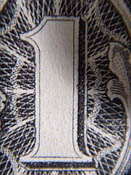 |
||
| Standard Macro | Macro with Flash | Super Macro |
The Samsung Digimax i5's normal macro setting performs well, capturing a small minimum area of 1.75 x 1.31 inches (45 x 33 millimeters). Detail is strong and resolution high, with a moderate amount of softening in the corners from the lens. (Most cameras have some softening in the corners in macro mode.) In Super macro mode, the minimum area measured only 0.53 x 0.40 inches (13 x 10 millimeters), however, details were rather soft throughout the frame. The flash had trouble throttling down for the macro area, and overexposed the shot beyond usage. (Plan on using external lighting for your closest macro shots with the i5.)
Distortion
Moderate barrel distortion, though low pincushion.
This is the tendency for the lens to bend straight lines outward (like a barrel--usually at wide angle) or inward (like a pincushion--usually at telephoto). The Digimax i5's 0.6% barrel distortion at wide angle is actually less than average among the cameras I've tested. At the telephoto end, the i5's 0.2% pincushion is fairly low.
| Barrel distortion at 39mm is 0.6% |
| Pincushion at 117mm is 0.2% |
Chromatic aberration
High chromatic aberration, several bright pixels of coloration.
 |
 |
| Wide: high and bright (top left @ 200%) |
Tele: virtually none (top left @ 200%) |
Chromatic aberration is rather high at wide angle, showing about 8-9 pixels of fairly bright coloration on either side of the target lines. At telephoto focal lengths though, chromatic aberration all but disappears. (This distortion is visible as a very slight colored fringe around the objects at the edges of the field of view on the resolution target.)
Corner Sharpness
Some softening in the left and right corners of the frame, strongest effect in the upper left corner.
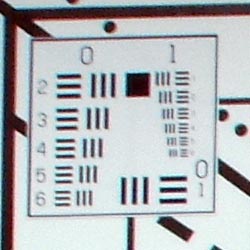 |
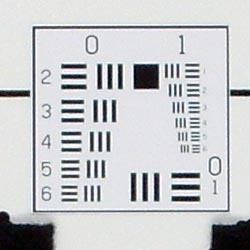 |
| Wide angle: Some softness in upper left corner. |
Wide angle: Reference from center of frame. |
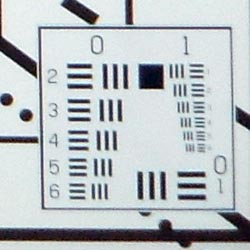 |
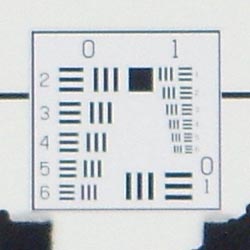 |
| Telephoto: Good sharpness (bottom right was the softest). |
Telephoto: Reference from center of frame. |
The Samsung Digimax i5 produced soft corners in a few shots, the greatest loss of sharpness occurring at wide angle focal lengths. At telephoto zoom settings, the centers were slightly softer than at wide angle, but the corners were sharper, producing a more uniform sharpness across the frame.
Sensor
Exposure and White Balance
Indoors, incandescent lighting
Problems with Auto, best color with the Incandescent white balance setting, lower than average exposure compensation required.
| Auto White Balance +0.3EV | Incandescent WB +0.3EV |
| Auto White Balance +0.3EV |
Color balance indoors under incandescent lighting was best with the Incandescent white balance setting, though the Manual option also produced pretty good results (just a bit reddish). The Auto setting resulted in a very strong orange cast, a problem for purely "point & shoot" users who may not know to use the other white balance options. The i5 only required a +0.3 EV exposure compensation boost to get a good exposure, much less than average for this shot. Overall color is slightly dark, most notably in the blue flowers, which have some purplish tints as well. (A very common outcome for this shot.) Our test lighting for this shot is a mixture of 60 and 100 watt household incandescent bulb, a pretty yellow light source, but a very common one in typical home settings here in the US.
Outdoors, daylight
Good color balance with the Auto setting, vibrant color. Better than average exposure accuracy.
| Auto White Balance, +0.7 EV | Daylight White Balance, +0.7 EV |
| Manual White Balance, +0.7 EV |
Outdoor shots generally showed slightly bright exposures with blown out highlights. The Auto white balance setting did the best job here, as the Daylight shot was quite orange, and the Manual shot slightly red. Shadow detail was also slightly limited, with high noise. Exposure accuracy overall was better than average, though, as the camera required less exposure compensation than average.
See full set of test images with explanations
See thumbnails of all test and gallery images
Resolution
High resolution, 1,200 lines of strong detail.
Our laboratory resolution chart revealed sharp, distinct line patterns down to about 1,200 lines per picture height, with extinction at around 1,800, a good performance for a 5-megapixel camera. (The camera produced slight color artifacts at lower line frequencies though, visible in the full-sized res target shots.) Use these numbers to compare with other cameras of similar resolution, or use them to see just what higher resolution can mean in terms of potential detail. Beware that while you might be able to make out what looks like distinct lines at numbers higher than those we've mentioned here, the camera is just doing its best to continue interpreting the lines. If you zoom in and follow them from the wider portions, you'll see the lines converge and reappear several times, so the lines you see at 1,500 and higher are really only artifacts generated by the camera's imaging system.
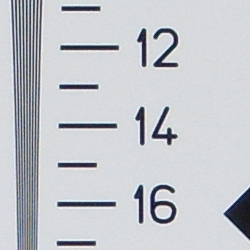 |
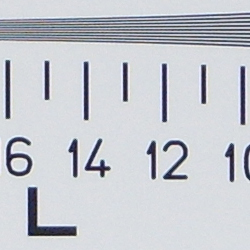 |
| Strong detail to 1,200 lines horizontal | Strong detail to 1,200 lines vertical |
See full set of test images with explanations
See thumbnails of all test and gallery images
Sharpness & Detail
Fairly crisp definition of high contrast subjects, though noise suppression does interfere quite a bit with lower contrast areas.
The Samsung Digimax i5's images are slightly soft overall, without any strong over-sharpening or edge enhancement on the camera's part, though definition of high-contrast details is actually pretty good. (Edge enhancement creates the illusion of sharpness by enhancing colors and tones right at the edge of a rapid transition in color or tone.)
Noise-suppression systems in digital cameras tend to flatten-out detail in areas of subtle contrast. The effects can often be seen in shots of human hair, where the individual strands are lost and an almost "watercolor" look appears. The crop at far right shows this, with very limited detail in the low-contrast area of her hair.
ISO & Noise Performance
Moderately high noise at the normal sensitivity settings, very high noise that blurs detail at the higher settings.
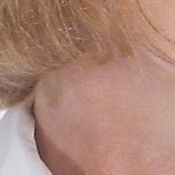 |
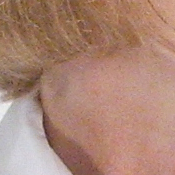 |
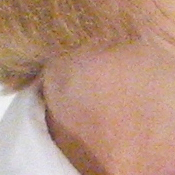 |
| ISO 100 | ISO 200 | ISO 400 |
The Samsung Digimax i5's ISO 100 setting produced moderately high noise, with only slightly blurred detail in the dark areas. As the ISO setting increases, so does the noise level and the amount of blurring that results, and its images at ISO 400 are quite soft, with bright noise pixels that alter the color balance.
Extremes: Sunlit and low light tests
High resolution with pretty good detail, though slightly high contrast and limited shadow detail with high noise. Pretty good low-light performance, capable of capturing bright images under average city street lighting and slightly darker conditions.
| +0.0 EV | +0.3 EV | +0.7 EV |
Sunlight:
Because digital cameras are more like slide film than negative film (in that they tend to have a more limited tonal range), we test them in the harshest situations to see how they handle scenes with bright highlights and dark shadows, as well as what kind of sensitivity they have in low light. The shot above is designed to mimic the very harsh, contrasty effect of direct noonday sunlight, a very tough challenge for most digital cameras. (You can read details of this test here.)
The i5 had a little trouble with the deliberately harsh lighting in the test above, producing slightly high contrast with strong highlights. Detail in the shadows was slightly limited, with high image noise. (In "real life" though, be sure to use fill flash in situations like the one shown above; it's better to shoot in the shade when possible.)
| 1 fc 11 lux |
1/2 fc 5.5 lux |
1/4 fc 2.7 lux |
1/8 fc 1.3 lux |
1/16 fc 0.67 lux |
|
| ISO 50 |
3 sec f3.5 |
6 sec f3.5 |
12 sec f3.5 |
16 sec f3.5 |
16 sec f3.5 |
Low light:
The Samsung Digimax i5 captures bright images to about 1/4 foot-candle, which is about 1/4 as bright as average city street lighting at night, so the i5 should do just fine with typical city night scenes. Color balance was slightly pink from the Auto white balance setting. Keep in mind that the i5's very long shutter times demand the use of a tripod or other camera support to get sharp photos. (A useful trick is to just prop the camera on a convenient surface, and use its self-timer to release the shutter. This avoids any jiggling from your finger pressing the shutter button, and can work quite well when you don't have a tripod handy.)
Color
Saturation & Hue Accuracy
Reasonably good color overall, though a tendency toward warmer, sometimes pink, color casts. Generally good hue accuracy.
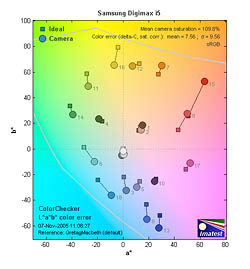 |
| In the diagram above, the squares show the original color, and the circles show the color that the camera captured. More saturated colors are located towards the periphery of the graph. Hue changes as you travel around the center. Thus, hue-accurate, highly saturated colors appear as lines radiating from the center. |
The other important part of color rendition is hue accuracy. Hue is "what color" the color is. The i5 performed pretty well here, though the dark blues of the flower bouquet were somewhat dark with purplish tints. - This doesn't show in the color error plot above right, but was apparent in the test photos themselves. what can be seen in the error plot is the tendency to shift cyans towards pure blue, a very common tactic to produce better-looking sky colors.
 |
||
Our random "Gallery" shots showed very pleasing color across a wide variety of subjects.
Viewfinder
Coverage
Nearly 100% accuracy with the LCD monitor.
| 39mm eq., LCD monitor | 117mm eq., LCD monitor |
The Samsung Digimax i5's LCD monitor proved very accurate, showing 99+ percent frame accuracy at both wide angle and telephoto.
Flash
Coverage and Range
The i5's flash has a slightly limited range, though our standard shots required less exposure compensation than average.
| 39mm equivalent | 117mm equivalent |
| Normal Flash +0.7 EV | Slow-Sync Flash +0.3 EV |
Flash coverage was uneven at wide angle, and still slightly uneven at telephoto. In the Indoor test, the flash on the i5 underexposed the subject slightly at its default setting, but required only +0.7 EV exposure compensation adjustment to get bright results, less than most cameras we test. The camera's Slow-Sync flash mode produced slightly brighter and more even results, albeit with a very strong orange cast from the room lighting. This shot required only a +0.3 EV exposure compensation adjustment.
| 8 ft | 9 ft | 10 ft | 11 ft | 12 ft | 13 ft | 14 ft |
1/60 sec f4.5 ISO 100 |
1/60 sec f4.5 ISO 100 |
1/60 sec f4.5 ISO 100 |
1/60 sec f4.5 ISO 100 |
1/60 sec f4.5 ISO 100 |
1/60 sec f4.5 ISO 100 |
1/60 sec f4.5 ISO 100 |
The Samsung i5's flash only dimly illuminated the Davebox target at eight feet, and intensity decreased incrementally from that point on. Subcompact digital cameras often have very limited flash range, and the i5 is no exception.
Output Quality
Print Quality
Good print quality, great color, very usable 11x14 inch prints. ISO 400 images are soft and a bit noisy at 8x10, fine at 5x7, great at 4x6.
Testing hundreds of digital cameras, we've found that you can only tell just so much about a camera's image quality by viewing its images on-screen. Ultimately, there's no substitute for printing a lot of images and examining them closely. For this reason, we now routinely print sample images from the cameras we test on our Canon i9900 studio printer, and on the Canon iP5000 here in the office. (See the Canon i9900 review for details on that model.)
With the Samsung Digimax i5, we found that it had enough resolution to make very good-looking 8x10 inch prints. At 11x14, its prints were a bit softer looking, but more than adequate for wall or table display. At high ISO, image noise levels were generally held in check, but at the cost of some image softness. ISO 200 photos looked fine printed at 8x10 inches, but ISO 400 ones were a little marginal there, with increased softness and visible colored flecks from image noise. They'd probably be fine for most people to display on a wall or table, but when looking at them more closely, we found the noise a little distracting. Dropping to a 5x7 print size greatly reduced the impact of the noise, and it was essentially invisible at 4x6 inches. Color-wise, the Samsung i5's images looked surprisingly good when printed on the i9900, with bright, vibrant color. We had expected to see the yellows and yellow-greens looking a little dull, based on the color error tests in the laboratory, but with "real life" subjects, the colors were very true and appealing looking. Skin tones were also quite good, the slightly pinkish rendering we observed on the computer screen not really being an issue in the prints. All in all, very good results for a subcompact camera.
Timing and Performance
Samsung Digimax i5 Timing
Slightly slower than average speed overall, though quick download.
| Startup/Shutdown: | |
| Power On to first shot | 1.6 seconds |
| Shutter response (Lag Time): | |
| Full Autofocus Wide |
0.73 second |
| Full Autofocus Tele |
1.06 second |
| Prefocused |
0.333 second |
| Cycle time (shot to shot) | |
| Normal large/fine JPEGJPEG | 1.64 seconds |
| Flash recycling | 4 seconds |
| Continuous mode | 1.03 second 0.97 frames/second (1 large/fine frame, buffer clears after each shot.) |
| Download speed | |
| Windows Computer, USB 2.0 | 2,846 KBytes/sec |
The Samsung i5's performance here is a little below average, with a modest startup time of 1.6 seconds, on the long side for cameras with internal lens assemblies, but faster than most models with telescoping lenses. Shutter response at full wide angle isn't too bad at 0.73 second, but the telephoto setting drags a little at 1.06 second. Shot to shot cycle times are on the slow side of average at about 1.64 seconds for large/fine JPEGs, though the camera clears the buffer after each shot and can continue capturing images at this rate for a while. - This also isn't too bad when compared to other subcompact models. Continuous-mode speed is slow, at only 0.97 frames/second, though again, the buffer clears after each shot. The flash takes about four seconds to recharge after a full-power shot, about average for this class of camera. Connected to a computer, download speeds are actually quite fast, at 2,846 KBytes per second.
Battery and Storage Capacity
Battery
Relatively short battery life, but not bad when compared to other subcompact models.
The Samsung i5 uses a small LiIon battery and has a custom power connector, so we couldn't perform our usual direct power-consumption measurements. The simple expedient of charging the battery fully and timing how long it took the camera would run in capture mode produced a run time of 87 minutes. This is on the short side when compared to full-size cameras, but fairly typical for subcompact models. Given the short run time, you should definitely consider purchasing a second battery to pack along on extended outings.
Storage
No card is included with the Digimax i5, although it accepts SD/MMC cards; 54MB RAM is built into the camera.
| 54MB Internal Memory |
Fine | Normal | Economy | |
| 2,592 x 1,944 | Images | 20 | 38 | 57 |
| File Size | 2.7 MB | 1.4 MB | 943 KB | |
| 2,272 x 1,704 | Images | 26 | 49 | 70 |
| File Size | 2.1 MB | 1.1 MB | 761 KB | |
| 2,048 x 1,536 | Images | 31 | 59 | 85 |
| File Size | 1.7 MB | 910 KB | 629 KB | |
| |
Images | 52 | 90 | 125 |
| File Size | 1.0 MB | 595 KB | 430 KB | |
| |
Images | 112 | 171 | 272 |
| File Size | 480 KB | 314 KB | 198 KB | |
| |
Images | 272 | 408 | 466 |
| File Size | 198 KB | 132 KB | 116 KB | |
I strongly recommend buying at least a 128MB card, preferably a 256MB one, to give yourself extra space for extended outings.
| Pro: | Con: |
|---|---|
|
|
| Free Photo Lessons | |
|




Follow Imaging Resource: